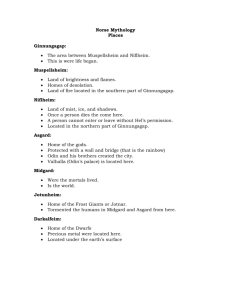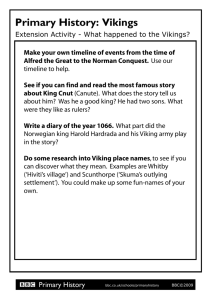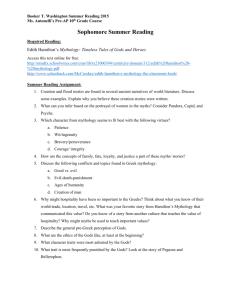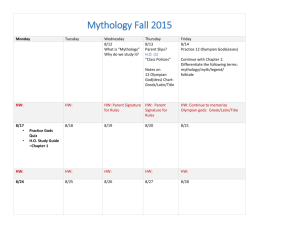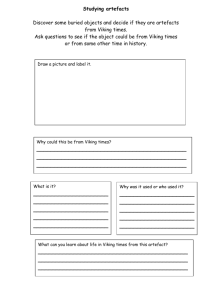Viking mythology
advertisement
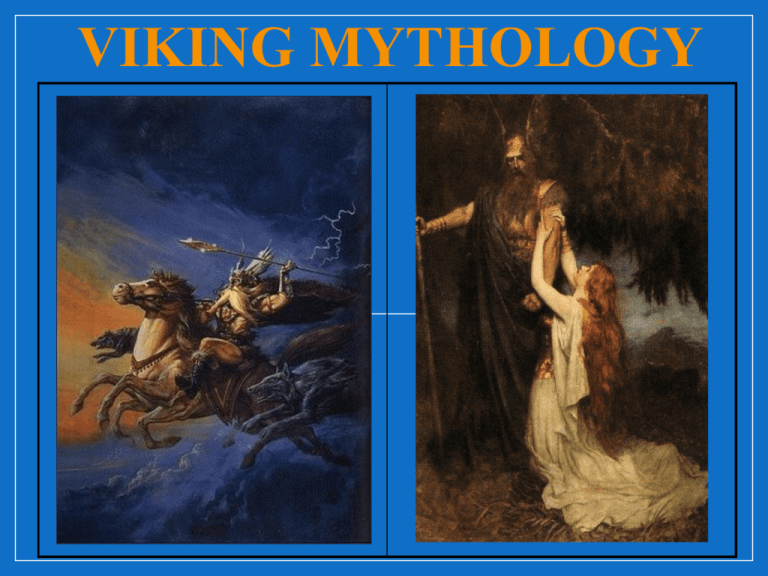
VIKING MYTHOLOGY 1 Outline • Introduction • Part I. The Vikings • Part II. Norse mythology • Part III. Viking gods • Part IV. Influence of Viking mythology • Conclusion • References 2 3 The Vikings began to raid their southern neighbors around 800 A.D. 4 Introduction • The Vikings are Nordic peoples—Danes, Swedes, and Norwegians—who raided and settled in Europe between 800 and 1100 • They attacked Russia, the British Isles, the Atlantic and North areas of France, Germany, and other Northern European countries • They eventually converted to Christianity and settled in the lands they had raided 5 6 The Vikings • Scandinavia, name applied collectively to three countries of northern Europe—Norway and Sweden, and Denmark. The three countries grouped because of their historical, cultural, and linguistic similarities • The Scandinavian world never came under Roman or Christian influence before the raids, and its population was small and dispersed • Because the people of this world mostly lived along the coasts, fishing played a significant part in their lives, as did sea trade 7 The Vikings • The basic social structure was that of small, free farmers who owed loyalty (along with taxes) to the headman or patriarch of the family • Men being away from home often, free women enjoyed a power unique in Europe 8 The Vikings • They traveled as far as North America in the West and Russia and Constantinople in the East Europe’s ability to resist their attacks grew; the Vikings settled and converted to Christianity • Christian • They were great sailors and ferocious enemies, but also great storytellers and hard workers 9 10 Viking mythology • They worshiped a number of gods, including Odin, the god of war and leader of the Norse gods; Thor, the god of thunder; and Balder, the god of light • Opposing the Norse gods were a host of evil giants, led by Loki 11 Viking mythology • Norse mythology had no scripture. The mythology was orally transmitted in the form of long, regular poetry • Storytellers were calls “skalds” 12 Odin, the Norse god of war and death, was accompanied by two wolves, Freki (translated as “fierce”) and Geri (translated as “greedy”). 13 Viking mythology • In Norse mythology, the earth is represented as a flat disc. This disk is situated in the branches of the world tree, or Yggdrasil • In ancient Germanic and Old Norse mythology, the universe was believed to consist of nine physical worlds joined together • The world of Men, the Middle-earth (or Midgard), lay in the centre of this universe. The lands of Elves, Gods, and Giants lay across an encircling sea 14 15 Viking mythology • The land of the Dead called Niflheim lay beneath the Middleearth and was ruled by Hel, daughter of Loki •A rainbow bridge, Bifrost Bridge, extended from Middleearth to Asgard across the sea. An outer sea encircled the seven other worlds 16 Viking mythology • After Odin created Middle Earth, he built Asgard, the home of the gods • There were many halls in Asgard for all the gods. Odin's hall had a roof of silver, and from it he could see all the worlds •A bridge stretched from Asgard to Yggdrasill, the World Tree, and this bridge was called Bifrost, the rainbow 17 Viking mythology • Viking warriors believed that if they died heroically they would be called to dwell with Odin in Valhalla • They were chosen by the Valkyries, women who wore armour, and rode swiftly over land and sea on horseback. The Valkyries also decided who would win a battle 18 Viking mythology • At the end of time, the frost and fire giants will meet together to fight the gods and destroy the worlds. This time will be called Ragnarok • The wolves chasing the Sun and Moon will catch and eat them, and there will be bitter cold. The earth will shake and mountains will fall, and even Yggrasill, the World Tree will tremble 19 Viking mythology • The wolf Fenrir will swallow Odin, but will be killed by Odin's son, Vadir. Thor attacks the World Serpent and kills it, but is poisoned by its venom. Loki will break free and attack Heimdall, the keeper of the rainbow bridge, which will get shattered • All the gods, monsters and giants will die, and the world will be burned, and then swallowed by the ocean. However, a new, better world will arise from the waves, lit by a new sun. 20 Viking gods • The dualism that exists is not evil vs. good, but order vs. chaos. • The gods represent order and structure whereas the giants and the monsters represent chaos and disorder 21 Brynhild begs Odin An illustration from F. L. Spence Rhine Legends (1915) 22 Viking gods: Odin • Father of Thor, Tyr and Balder; • Title: The Cunning god • god of war and death, but also the god of poetry and wisdom • He invented Runes, the secret writing of the Saxons and Vikings, which not only stored knowledge, but could be used for magic 23 Thor, god of thunder, son of Odin. "Thor's Day" is Thursday in English. He is the homologue of Zeus. Here picture of the Marvel Comics Hero. 24 Viking gods: Thor • Title: Thunder God; • Son of Odin • He holds Mjolnir, one of the mightiest weapons of both man and god • Married to Sif, a fertility goddess • He was very popular as the protector of both gods and humans against the forces of evil 25 Loki is connected with fire and magic, and can assume many different shapes (horse, falcon, fly). He is directly responsible for the death of Balder, the god of light. Here fighting with Thor 26 Viking gods: Loki • Loki is not a member of the Asgardians, but the son of Laufey, the deceased monarch of the Frost Giants, the ancient enemies of the Asgardians • Odin took Loki and raised him as his son alongside his biological son Thor • Loki was not always evil; he helped Thor on many adventures • He had monstrous children, Fenrir the wolf, the World Serpent and Hela, queen of the dead 27 Influence of Viking mythology • Conan the Barbarian • Tolkien (Lord of the Rings) • Dungeons and Dragons are based on the work of various fantasy authors (including Howard and Tolkien) and many mythologies, including Norse mythology • In the Marvel Universe, Thor has been one of the longest running superheroes for the company 28 Influence of Viking mythology • The Germanic gods have left traces in modern English vocabulary • An example of this is some of the names of the days of the week 29 Influence of Viking mythology 30 Key Questions 1. What values do the Norse people hold? 2. How are these values reflected in the Norse oral stories and written texts? 31 References • http://encarta.msn.com/encyclopedia_761561500/Vikings.html • http://www.pantheon.org/articles/b/brunhilde.html • http://odin.dep.no/odin/engelsk/norway/history/032005- 990460/index-dok000-b-n-a.html • http://www.bbc.co.uk/history/ancient/vikings • http://en.wikipedia.org/wiki/J._R._R._Tolkien • http://www1.pu.edu.tw/~bmon/Fairy.htm#internet • http://en.wikipedia.org/wiki/Thor_(Marvel_Comics) • http://www.bartleby.com/61/23/O0032300.html • http://www.sacred-texts.com/neu/tml/index.htm • http://www.mainlesson.com/display.php?author=keary&book=a sgard&story=_contents 32 33

